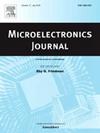An energy-efficient data-reused on-the-fly Im2col for OS-dataflow systolic array-based accelerator
IF 1.9
3区 工程技术
Q3 ENGINEERING, ELECTRICAL & ELECTRONIC
引用次数: 0
Abstract
The rapid development of AI technology has made the systolic array, capable of massively parallel computations, one of the most commonly used computational architectures for AI inference. The im2col transformation is required to convert the operation into matrix multiplication for convolution, resulting in inflated input data and increased power consumption for data transmission. This work proposes a low-power, on-the-fly im2col scheme based on data reuse. By delaying or preloading certain input rows, redundant data can be aligned in timing, eliminating the need for extensive intermediate buffers in the im2col module. Additionally, this paper discusses the design of the systolic array for irregular input dataflow and provides hardware support for 1 1 and 3 3 convolution modes. The proposed design has been tested and implemented on the ZYNQ UltraScale+ ZU4EV. Experiment results show that the hardware implementation of the im2col module consumes only 610 LUTs and 465 FFs, with a power consumption of just 6.51 mW, demonstrating better power consumption than previous works.
基于操作系统数据流收缩阵列加速器的高效数据复用Im2col
随着人工智能技术的飞速发展,具有大规模并行计算能力的收缩阵列成为人工智能推理最常用的计算架构之一。为了将运算转换为矩阵乘法进行卷积,需要进行im2col变换,这会导致输入数据膨胀,增加数据传输的功耗。本文提出了一种基于数据重用的低功耗动态im2col方案。通过延迟或预加载某些输入行,可以定时对齐冗余数据,从而消除了在im2col模块中使用大量中间缓冲区的需要。此外,本文还讨论了不规则输入数据流的收缩阵列设计,并提供了1 × 1和3 × 3卷积模式的硬件支持。所提出的设计已在ZYNQ UltraScale+ ZU4EV上进行了测试和实现。实验结果表明,im2col模块的硬件实现仅消耗610 lut和465 FFs,功耗仅为6.51 mW,比以往的工作功耗更低。
本文章由计算机程序翻译,如有差异,请以英文原文为准。
求助全文
约1分钟内获得全文
求助全文
来源期刊

Microelectronics Journal
工程技术-工程:电子与电气
CiteScore
4.00
自引率
27.30%
发文量
222
审稿时长
43 days
期刊介绍:
Published since 1969, the Microelectronics Journal is an international forum for the dissemination of research and applications of microelectronic systems, circuits, and emerging technologies. Papers published in the Microelectronics Journal have undergone peer review to ensure originality, relevance, and timeliness. The journal thus provides a worldwide, regular, and comprehensive update on microelectronic circuits and systems.
The Microelectronics Journal invites papers describing significant research and applications in all of the areas listed below. Comprehensive review/survey papers covering recent developments will also be considered. The Microelectronics Journal covers circuits and systems. This topic includes but is not limited to: Analog, digital, mixed, and RF circuits and related design methodologies; Logic, architectural, and system level synthesis; Testing, design for testability, built-in self-test; Area, power, and thermal analysis and design; Mixed-domain simulation and design; Embedded systems; Non-von Neumann computing and related technologies and circuits; Design and test of high complexity systems integration; SoC, NoC, SIP, and NIP design and test; 3-D integration design and analysis; Emerging device technologies and circuits, such as FinFETs, SETs, spintronics, SFQ, MTJ, etc.
Application aspects such as signal and image processing including circuits for cryptography, sensors, and actuators including sensor networks, reliability and quality issues, and economic models are also welcome.
 求助内容:
求助内容: 应助结果提醒方式:
应助结果提醒方式:


